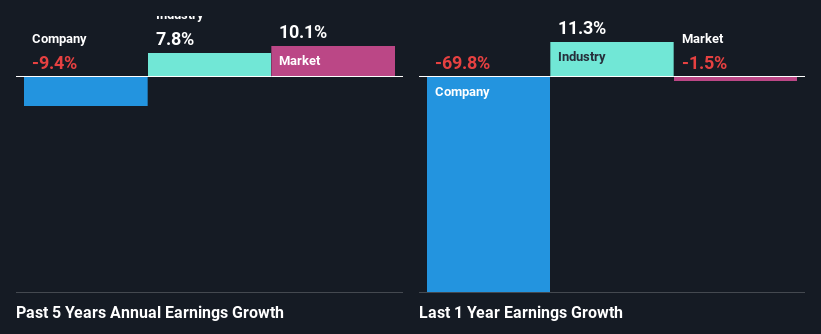YKGI Limited's (Catalist:YK9) Dismal Stock Performance Reflects Weak Fundamentals
YKGI (Catalist:YK9) has had a rough week with its share price down 15%. To decide if this trend could continue, we decided to look at its weak fundamentals as they shape the long-term market trends. Specifically, we decided to study YKGI's ROE in this article.
Return on equity or ROE is an important factor to be considered by a shareholder because it tells them how effectively their capital is being reinvested. In other words, it is a profitability ratio which measures the rate of return on the capital provided by the company's shareholders.
Check out our latest analysis for YKGI
How To Calculate Return On Equity?
Return on equity can be calculated by using the formula:
Return on Equity = Net Profit (from continuing operations) ÷ Shareholders' Equity
So, based on the above formula, the ROE for YKGI is:
8.2% = S$1.4m ÷ S$17m (Based on the trailing twelve months to December 2023).
The 'return' is the income the business earned over the last year. So, this means that for every SGD1 of its shareholder's investments, the company generates a profit of SGD0.08.
Why Is ROE Important For Earnings Growth?
So far, we've learned that ROE is a measure of a company's profitability. Depending on how much of these profits the company reinvests or "retains", and how effectively it does so, we are then able to assess a company’s earnings growth potential. Generally speaking, other things being equal, firms with a high return on equity and profit retention, have a higher growth rate than firms that don’t share these attributes.
YKGI's Earnings Growth And 8.2% ROE
At first glance, YKGI's ROE doesn't look very promising. However, given that the company's ROE is similar to the average industry ROE of 7.6%, we may spare it some thought. But then again, YKGI's five year net income shrunk at a rate of 9.4%. Remember, the company's ROE is a bit low to begin with. Therefore, the decline in earnings could also be the result of this.
So, as a next step, we compared YKGI's performance against the industry and were disappointed to discover that while the company has been shrinking its earnings, the industry has been growing its earnings at a rate of 7.8% over the last few years.
Earnings growth is an important metric to consider when valuing a stock. What investors need to determine next is if the expected earnings growth, or the lack of it, is already built into the share price. This then helps them determine if the stock is placed for a bright or bleak future. If you're wondering about YKGI's's valuation, check out this gauge of its price-to-earnings ratio, as compared to its industry.
Is YKGI Using Its Retained Earnings Effectively?
YKGI has a high three-year median payout ratio of 71% (that is, it is retaining 29% of its profits). This suggests that the company is paying most of its profits as dividends to its shareholders. This goes some way in explaining why its earnings have been shrinking. With only very little left to reinvest into the business, growth in earnings is far from likely. Our risks dashboard should have the 5 risks we have identified for YKGI.
In addition, YKGI only recently started paying a dividend so the management probably decided the shareholders prefer dividends even though earnings have been shrinking.
Summary
Overall, we would be extremely cautious before making any decision on YKGI. The company has seen a lack of earnings growth as a result of retaining very little profits and whatever little it does retain, is being reinvested at a very low rate of return. Until now, we have only just grazed the surface of the company's past performance by looking at the company's fundamentals. To gain further insights into YKGI's past profit growth, check out this visualization of past earnings, revenue and cash flows.
Have feedback on this article? Concerned about the content? Get in touch with us directly. Alternatively, email editorial-team (at) simplywallst.com.
This article by Simply Wall St is general in nature. We provide commentary based on historical data and analyst forecasts only using an unbiased methodology and our articles are not intended to be financial advice. It does not constitute a recommendation to buy or sell any stock, and does not take account of your objectives, or your financial situation. We aim to bring you long-term focused analysis driven by fundamental data. Note that our analysis may not factor in the latest price-sensitive company announcements or qualitative material. Simply Wall St has no position in any stocks mentioned.

 Yahoo Finance
Yahoo Finance 
